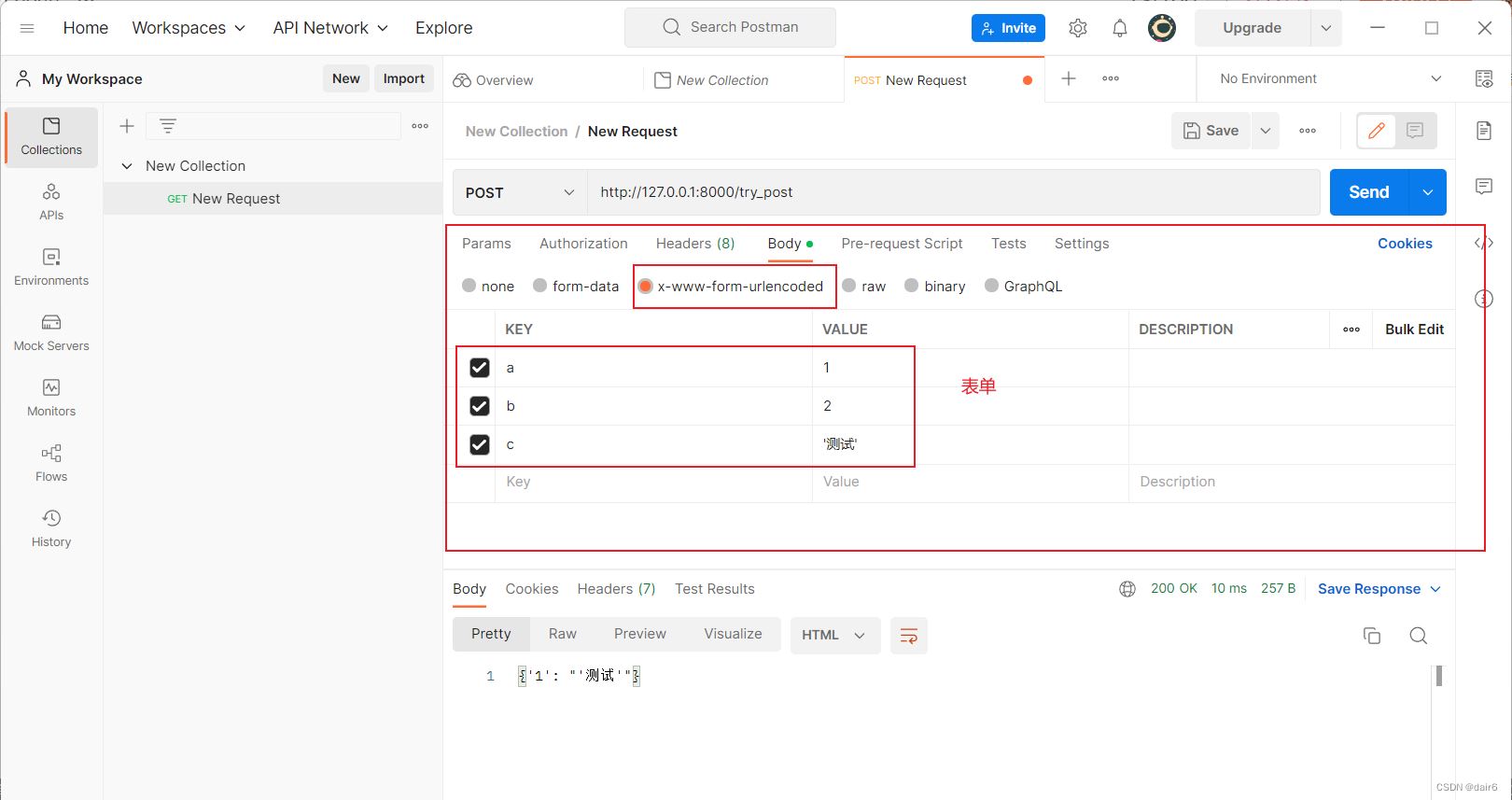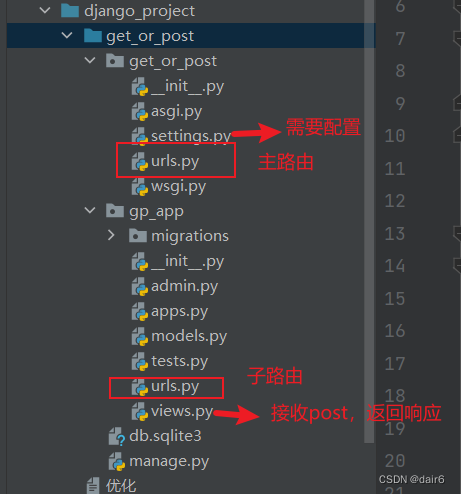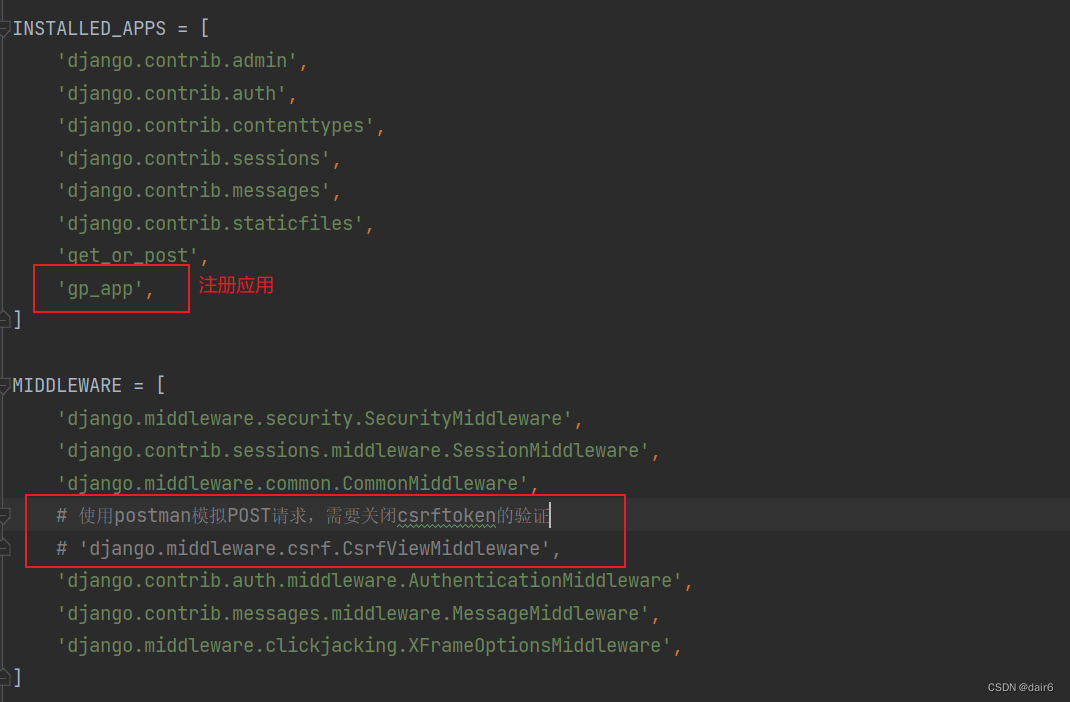这篇教程python中的post请求解读写得很实用,希望能帮到您。
python post请求post请求有4中编码方式
1.application/x-www-form-urlencodedapplication/x-www-form-urlencoded是浏览器原生的form表单 提交的数据会按照key1=val1&key2=val2的格式,经过url转码,然后传输
(1)发送post请求我们除了可以直接编写代码发送post请求,也可以使用postman来构造post请求 使用代码: import requestsurl = 'https://www.xxxxxx.com/'# 需要注意的是Content-Length参数如果没有,data表单则不会随着请求被发送给服务端,且使用fiddler抓包的过程中,也无法看到data表单headers = { 'Content-Type': 'application/x-www-form-urlencoded', 'Content-Length':'<calculated when request is sent>'}data = {'a': 1, 'b': 2,'c':'测试'}result = requests.post(url, headers=headers, data=data)print(result.content.decode('utf-8'))使用postman 

(2)截获post请求,使用fiddler
(3)接收post请求,返回响应使用django3的版本,目录结构如下 
settings的配置 
主路由的配置 from django.contrib import adminfrom django.urls import path, re_path, includeurlpatterns = [ path('admin/', admin.site.urls), # 将主路由和子路由绑定 path('', include('gp_app.urls')),]子路由的配置 from django.urls import re_pathfrom . import viewsurlpatterns = [ # name用于给视图命名,可以通过reverse反向解析 re_path(r'try_get/', views.get, name='get请求'), re_path(r'try_post', views.post, name='post请求')] views.py的配置 from django.shortcuts import renderfrom django.http import HttpResponse# Create your views here.def get(request): if request.method == 'get': print(request.GET.getlist('c')) pass return HttpResponse("ok")def post(request): if request.method == 'POST': print("request.method:", request.method) print("request.POST.getlist('a'):", request.POST.getlist('a')) print("request.POST.getlist('b'):", request.POST.getlist('b')) print("request.POST.getlist('c'):", request.POST.getlist('c')) print("request.POST:", request.POST) a = request.POST.get('a', 0) c = request.POST.get('c', 0) d = str({a: c}) # 需要注意的是,如果要使用HttpResponse来返回响应,参数需要是字符串,d如果不转换成str,返回的结果就是1 return HttpResponse(d)运行django之后,控制台的结果 
(4)data表单使用嵌套的数据结构如何处理情况1:使用json_dumps postData = { 'tid': 1'', 'data': [{'name': 'rqlx', 'value': '0', 'sword': 'attr'},{'name': 'rq1', 'value': '1', 'sword': 'attr'}], 'bindParam': 'true' }# 注意json.dumps转换成json格式,或许也能写成# data = json.dumps({'postData':{ 'tid': 1'', 'data': [{'name': 'rqlx', 'value': '0'},{'name': 'rq1', 'value': '1'}], 'bindParam': 'true'}})# 将json.dumps放在外层data = { 'postData':json.dumps(postData) }resp = requests.post( url=url, data=data, headers=headers, # cookies=dict_cookie, # cookie也可以用字典的形式写到headers,类似于'Cookie':'xxxxxxxxxx' timeout=240,)情况2:使用url编码 有的时候表单提交时,需要先进行url转码,关键在于后端到底要接收什么类型的数据,如果我们不知道后端能处理的数据,有时就只能靠猜,用不同的方法尝试将表单处理成能被后端解析的格式 from urllib.parse import urlencodedata = {‘a': 1, ‘b': 2,‘c':‘测试'}data =urlencode(data)resp = reuquest.post(url=url,headers=headers,data=data)
2.multipart/form-data- multipart/form-data是常用来上传文件的表单
- application/json
- text/xml
总结以上为个人经验,希望能给大家一个参考,也希望大家多多支持本站。
python中geopandas库安装出现各种问题的解决办法
Python自动检测requests所获得html文档的编码 |

